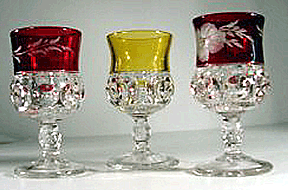 For
more than a decade, Ed Kleppinger has been looking through
rose-colored glasses. No, not eyeglasses but rather his collection of
thousands of pieces of ruby stain pattern glass, the common man’s
red-decorated pressed glass of the Victorian Era–much of which he has
on display in 35 cases in his rebuilt 1880s Creole cottage in the
Faubourg Marigny district of New Orleans, Louisiana.
For
more than a decade, Ed Kleppinger has been looking through
rose-colored glasses. No, not eyeglasses but rather his collection of
thousands of pieces of ruby stain pattern glass, the common man’s
red-decorated pressed glass of the Victorian Era–much of which he has
on display in 35 cases in his rebuilt 1880s Creole cottage in the
Faubourg Marigny district of New Orleans, Louisiana.
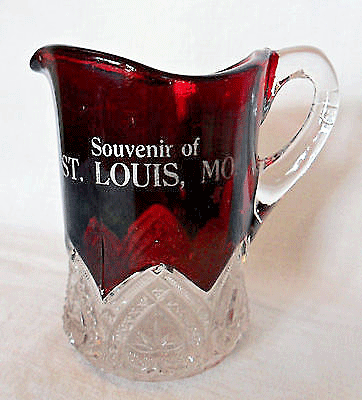 Most people may know this type of glass as it was used profusely for
souvenirs, marked with the name of the city and date, from the latter
part of the 19th Century to well into the 20th.
But Kleppinger’s collection goes way beyond mere souvenir glass.
Most people may know this type of glass as it was used profusely for
souvenirs, marked with the name of the city and date, from the latter
part of the 19th Century to well into the 20th.
But Kleppinger’s collection goes way beyond mere souvenir glass.
"My mother collected ruby stained," Kleppinger said.
"I started collecting to round out her collection."
Unfortunately, his brother inherited their mother’s collection.
"For many people, it was the first beautiful thing they
had," said Kleppinger, who lives in the third house of the
six-house compound he owns. "They might be living in a sod hut in
North Dakota, but they had it, and they took care of it...and they could
afford it."
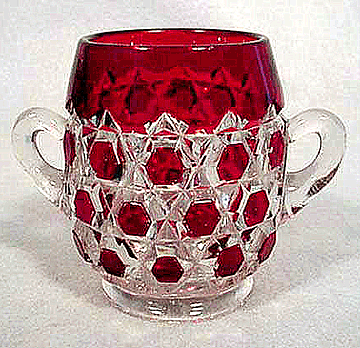 Kleppinger, who’s a chemist with an engineering background, likes
glass because it’s so unique and, to him, ruby stained glass is one of
the most unusual forms that came out of the 19th-century
glass industry. "I like living with the glass and trying to puzzle
out its mysteries," he added. "I see something new everyday,
something to try to understand."
Kleppinger, who’s a chemist with an engineering background, likes
glass because it’s so unique and, to him, ruby stained glass is one of
the most unusual forms that came out of the 19th-century
glass industry. "I like living with the glass and trying to puzzle
out its mysteries," he added. "I see something new everyday,
something to try to understand."
"My parents cooperated on only two things," he said.
"I’m the product of one. Their collection of ruby stain pressed
glass was the other. Years ago I thought it was a beautiful collection
that should be preserved. I started talking to museums and people who
had donated collections. I discovered that museums really don’t want
collections and will accept them only if they’re accompanied by a lot
of money or have no restrictions placed on them."
After doing a lot of research, Kleppinger realized that his mother’s
collection of ruby stain glass did not contain all of the patterns, much
less the forms. So he and his late wife, Willi, decided to "buy a few
pieces to fill in the collection," once he settled with his brother
over custody of it. After amassing even more pieces, he decided that he
would build his own museum for ruby stain pattern glass and thus create
his own rules.
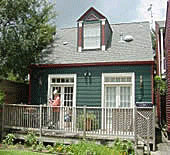 Kleppinger’s collection, which also includes thousands of pieces
packed away, is a testament to the loveliness and delicacy of this type
of glass. His privately displayed collection fills a picturesque,
correctly humidified, lighting-temperature-controlled, rebuilt, two-bay
Creole cottage. He houses the boxed portion of his collection in the
raised basement of one of his adjacent houses. The collection, housed in
tall glass mirror-backed cases, takes up both floors.
Kleppinger’s collection, which also includes thousands of pieces
packed away, is a testament to the loveliness and delicacy of this type
of glass. His privately displayed collection fills a picturesque,
correctly humidified, lighting-temperature-controlled, rebuilt, two-bay
Creole cottage. He houses the boxed portion of his collection in the
raised basement of one of his adjacent houses. The collection, housed in
tall glass mirror-backed cases, takes up both floors.
Though manufacturers produced thousands of patterns of pressed glass
at the peak of production between the 1880s and 1920s, only a few of
these patterns ever became ruby stained. So Kleppinger’s collection,
which is perhaps the largest of its kind in the country, is an important
one.
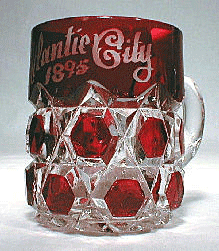 "It was made to mimic cut glass," Kleppinger said,
"and to look expensive. To create ruby stain, glass makers applied
heavy paint made of molasses and copper salts to certain areas, and then
refired the glass piece. They colored few all over. Most had ruby stain
applied on only a small portion." Amber stain is a similar process,
and Kleppinger owns examples of the two rare patterns that used both
amber and ruby stains.
"It was made to mimic cut glass," Kleppinger said,
"and to look expensive. To create ruby stain, glass makers applied
heavy paint made of molasses and copper salts to certain areas, and then
refired the glass piece. They colored few all over. Most had ruby stain
applied on only a small portion." Amber stain is a similar process,
and Kleppinger owns examples of the two rare patterns that used both
amber and ruby stains.
Kleppinger’s collection shows the ingenuity of glass makers and
pieces made from the same molds. Although manufacturers made very few
plates in the early years, Kleppinger owns a rare plate in the "Navajo"
pattern,
made by flattening a bowl. Beside it rests the same plate with the edges
folded up to become a banana bowl.
"Some ruby stain collectors can’t be bothered with the
souvenir pieces," said Kleppinger. "I have six-inch ruby
stained glass shovels and hatchets, dainty shoes, baskets, pin trays,
and a pair of solid-color opera glasses marked ‘Souvenir of North
Dakota.’ And one of my ashtrays still has the 35-cent price tag on the
bottom."
Understandably, Kleppinger views his collection with pride. He even
has a case full of unknown examples–pieces he has yet to identify.
Unfortunately, ruby stained glass can easily be faked. This case holds
an example of a piece from which red nail polish washed off the surface
while he was cleaning it.
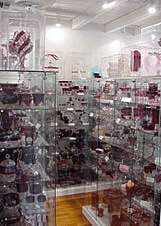 Currently, Kleppinger has what he calls a proto-museum. He
hopes to create a larger, more permanent ruby stain museum if he can
find the financial help he needs. He foresees this as a museum that
would display donated collections of both ruby and regular pattern
glass. In it, Kleppinger hopes to focus on pattern glass, with the goal
of creating a comprehensive, in-depth study collection, of which ruby
stain pattern glass will be the first category to be collected.
Currently, Kleppinger has what he calls a proto-museum. He
hopes to create a larger, more permanent ruby stain museum if he can
find the financial help he needs. He foresees this as a museum that
would display donated collections of both ruby and regular pattern
glass. In it, Kleppinger hopes to focus on pattern glass, with the goal
of creating a comprehensive, in-depth study collection, of which ruby
stain pattern glass will be the first category to be collected.
Kleppinger envisions a museum where collectors could be confident
that their collections won’t be broken up. The museum would prepare a
written agreement covering the terms and conditions in accepting a
donation with the intent to preserve collections and not de-accession
them. Needless to say, there will be duplication in such a plan.
According to Kleppinger, his permanent museum will operate in an open
concept. Storage areas will be set up so that visitors would be able to
browse through them, while keeping the glass safe. Examples of
less-perfect pieces would be available for hands-on examination by
visitors using special foam-covered tables. "No other museum has
taken this approach," he added. "In addition, the collection
will be electronically photo indexed and available to both researchers
and visitors."
When Kleppinger finally finds the funds, he hopes to have his museum
fully accredited in five years, with the possibility of it being
affiliated with the Smithsonian Institution in Washington, D.C.
The other thing they Kleppinger plans is a definitive reference. His
cottage currently holds a library of reference books about glass, and he
owns the copyright to a classic reference by William Heacock called The
Encyclopedia of Victorian Colored Pattern Glass, Book 7, Ruby-Stained
Glass from A to Z, which he’s currently updating. He’s also
documenting all of the patterns made in ruby stain. "At least 50,
maybe 100, weren’t in the book," he said, "which listed 350
when it was published in 1986."
And paraphrasing a common phrase of suburban mall developers,
Kleppinger said, " If you build it, the contents will come."
